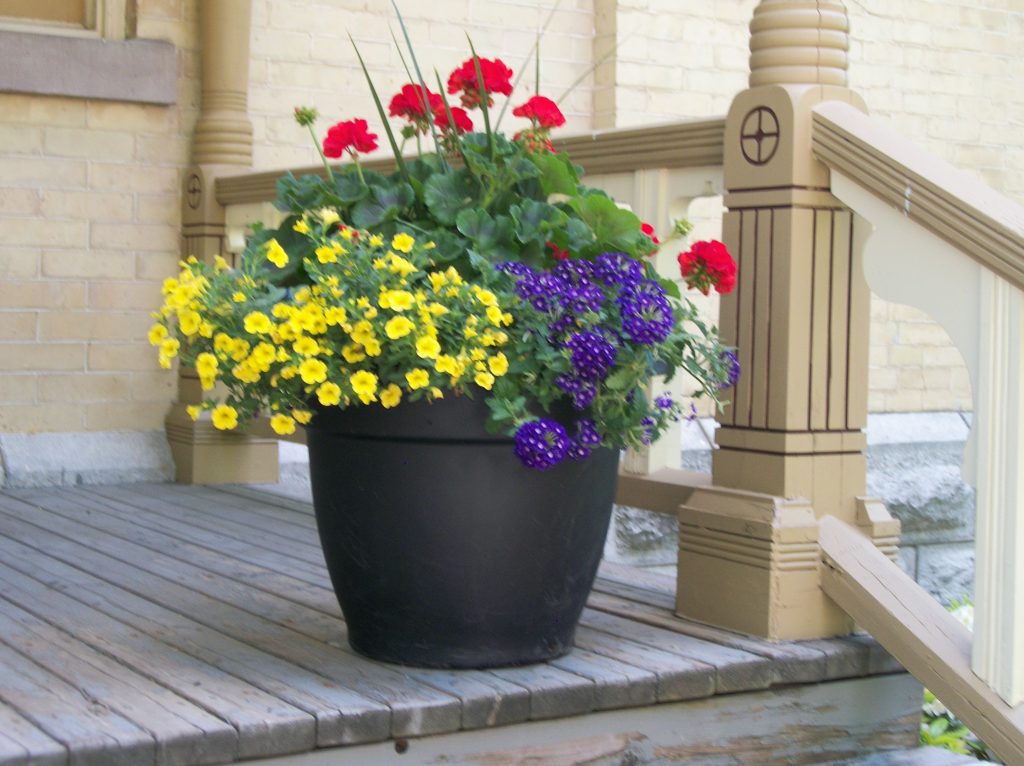It’s Still Just Dirt, The Tillsonburg News – June 2020
by Angela Lassam
Everywhere you look there are hanging baskets and patio containers full of color to brighten our outdoor living spaces. They will not stay that way without some care and attention. There are three things you must do to keep them looking as good as when they were purchased – watering, fertilising and deadheading.

Watering daily may not be necessary depending on where they are placed. Check the moisture in the pot first, then if needed you can water until the water runs out the bottom. Many pots are very full so heavy watering is necessary to get to all the roots. A good check to see if you are watering properly is to lift the pot before watering. If it is light and the soil is light brown it needs water. A light sprinkling is not enough and can damage the leaves.
Planters and hangers that you buy, normally have a hole for drainage but if you assemble your own make sure there is adequate drainage in the bottom. If there is no hole you must make one otherwise your plants will remain water logged and get root rot. Patio planters will benefit from being slightly raised off the ground, porch or deck. A hoop of some sort or a trivet– check out the $ store is a suggestion.
To keep your plants growing well they will need fertiliser at least once a week. Usually it is powder which is mixed in a watering can and poured on the soil, not on the leaves as if they are too warm they will burn. There are fertilisers especially for good blooming and worth the investment as a container will go a long way and if stored correctly it will last a long time. Fertiliser is an important part of keeping your planter vibrant and continuously flowering. It is better to start with a solution of half strength. Make it a weekly routine to fertilise all containers. Most arrangements have a slow release fertiliser added before it is sold. Home planted ones will need this when planted as well as regular fertiliser watering. Miracle Gro make spikes or sticks specifically for this.
A daily thing to do when checking the dryness of your containers is to deadhead which means to remove all dead flowers and if necessary dried, damaged leaves. If the heads are left on they will form a seed and not continue blooming. Later in the season you can cut back the long ‘leggy’ ones and they will branch out again making new growth. Some gardeners take the main bloom away as soon as they buy their planter to allow the plant head to split into many bracts making more flowers per plant. As the season flows you may need to remove dead or unsightly plants and replace with later flowering ones. This adds the chance to follow the flowering season.
When a container is not doing well consider moving it as there are both shade lovers and sun worshipers in flower categories and plants are not usually labelled so it can be difficult for a first-time buyer. Try to ask at the nursery as it will make a big difference to your display of summer color. Begonias, fuchsia, impatiens especially the African type, coleus and trailing lobelia all prefer shade.
People buy flowers to surround us with color but whatever you grow take the time to enjoy the bright natural colors that summer gives us.
The Tillsonburg Horticultural Society is continuing with a Covid 19 watch and will inform members of any updates so watch Facebook or check in on the website www.tillsonburghorticultural.ca . Meanwhile be well, be safe.